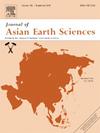高振幅磁异常带在台湾中西部地震构造中的意义
IF 2.4
3区 地球科学
Q2 GEOSCIENCES, MULTIDISCIPLINARY
引用次数: 0
摘要
在台湾中西部有一个独特的地壳高磁化带,称为陆康磁化高带(Lukang magne磁化高带,LMH),被认为对台湾中部的地震活动有重要影响。根据台湾地区的磁异常特征,LMH是南海北部大陆边缘高振幅磁异常带(NSCSMA)东段的反演结果。为了更好地了解这一磁高压与背景构造特征之间的联系,本研究分析了台湾中西部地区的磁资料。我们利用小波谱分析和紧凑反演技术来确定其成因。小波谱分析结果表明,HMAZ主要磁信号的波长为180 km,表明震源深度约为25 km。致密反演结果显示,高磁化率物质分布在20 ~ 30 km深度附近。纵波速度模型表明,HMAZ的成因可能位于下地壳和/或上地幔,属于欧亚板块。根据前人NSCSMA的分析结果和我们的观察,我们提出蛇纹石化物质可能是HMAZ的原因来源。此外,根据区域地震活动特征,我们的研究结果表明,变形锋在台湾中西部地震构造中的作用比HMAZ更重要。本文章由计算机程序翻译,如有差异,请以英文原文为准。

The significance of the high-amplitude magnetic anomaly belt in the seismotectonics of mid-west Taiwan
In mid-west Taiwan, there is a unique zone with high crustal magnetization called Lukang Magnetization High (LMH), which is believed to significantly influence earthquake activity in middle Taiwan. According to the magnetic anomaly feature in the Taiwan region, the LMH is the inversion result of the eastern part of the high-amplitude magnetic anomaly zone (NSCSMA) found in the northern South China Sea continental margin. To better understand the connection between this magnetic high (HMAZ) and background tectonic features, this study analyzes the magnetic data in mid-west Taiwan. We used wavelet spectrum analysis and compact inversion techniques to determine its causal source. Wavelet spectrum analysis results show that the wavelength of the major magnetic signal of the HMAZ is 180 km, indicating the source depth of approximately 25 km. The compact inversion results reveal high-susceptibility materials distributed around 20–30 km depth. P-wave velocity models suggest that the causal source of the HMAZ could be located in the lower crust and/or upper mantle and belong to the Eurasia plate. Based on the previous analysis results of the NSCSMA and our observation, we propose that the serpentinized materials may be the causal source of the HMAZ. Moreover, based on the regional seismicity characteristics, our findings indicate that the deformation front plays a more crucial role in the seismotectonic of mid-west Taiwan than the HMAZ.
求助全文
通过发布文献求助,成功后即可免费获取论文全文。
去求助
来源期刊

Journal of Asian Earth Sciences
地学-地球科学综合
CiteScore
5.90
自引率
10.00%
发文量
324
审稿时长
71 days
期刊介绍:
Journal of Asian Earth Sciences has an open access mirror journal Journal of Asian Earth Sciences: X, sharing the same aims and scope, editorial team, submission system and rigorous peer review.
The Journal of Asian Earth Sciences is an international interdisciplinary journal devoted to all aspects of research related to the solid Earth Sciences of Asia. The Journal publishes high quality, peer-reviewed scientific papers on the regional geology, tectonics, geochemistry and geophysics of Asia. It will be devoted primarily to research papers but short communications relating to new developments of broad interest, reviews and book reviews will also be included. Papers must have international appeal and should present work of more than local significance.
The scope includes deep processes of the Asian continent and its adjacent oceans; seismology and earthquakes; orogeny, magmatism, metamorphism and volcanism; growth, deformation and destruction of the Asian crust; crust-mantle interaction; evolution of life (early life, biostratigraphy, biogeography and mass-extinction); fluids, fluxes and reservoirs of mineral and energy resources; surface processes (weathering, erosion, transport and deposition of sediments) and resulting geomorphology; and the response of the Earth to global climate change as viewed within the Asian continent and surrounding oceans.
 求助内容:
求助内容: 应助结果提醒方式:
应助结果提醒方式:


